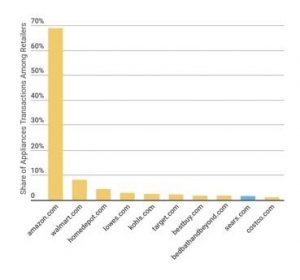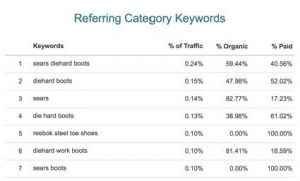Sears, which long ago pioneered an early form of ecommerce through its catalog business, didn’t foresee a shifting landscape that started 25 years ago in Jeff Bezos’ garage in Seattle.
While the U.S. retail giant could have carved out a strong presence in ecommerce, it failed to act back in 2005 when Amazon became the leading internet retailer. Instead, it launched its own big-box retail chains to try to turn tide on market share loss from Walmart, Target and others.
Eleven years later in 2016, former CEO Eddie Lambert who stepped down after Sears filed for bankruptcy last month, warned of disruption to retailers like “Walmart, Nordstrom, Macy’s, Staples, Whole Foods and many others have felt the impact of disruptive changes from online competition and new business models.” Like many other retailers struggling to survive like Toys “R” Us, JCPenney and Macy’s, Sears is closing 142 unprofitable stores by the end of this year.
Insights on Sears.com traffic and conversions
To better understand Sears’ under-performance in the rising ecommerce economy, we analyzed data from Jumpshot’s panel of 100 million devices that tracks more than five billion consumer actions per day. The data ranges from January 2017 to September 2018.
One key finding is that Sears has barely grown online transaction volume for nearly two years. Through September, it posted almost exactly the same number of purchases, growing just 0.03% year over year. Traffic to the site has been declining. It’s down 16% for the year.
While that means Sears is converting at a slightly higher rate with less traffic, the bad news is almost half of search engine traffic now comes from paid search ads. That’s up from just over 20% from the same time last year. Nearly half of its traffic comes from Google promotions.
Sears’ private-label strategy didn’t stand the test of time
The value for Sears’ historically strong brands like Craftsman, DieHard, and Kenmore has lost its luster. The retailer manufactured or sourced high-quality products to earn lasting trust that spanned generations and used them to generate loyalty. But, Sears failed to realize it could not rely on brand affinity forever, especially since brand loyalty is prevalent mostly among older generations who are the majority of Sears’ customer base. Instead, it’s limped along using the goodwill it’s generated to maintain sales or sell off its brands as assets.
In comparison, Amazon’s winning private-label strategy has focused on acquiring retail dominance and then moving in on established brands with its own often cheaper and lower-quality products to squeeze out the competition.
Jumpshot data shows that Sears’ strongest categories online are tools, appliance and shoes. Combined, they account for about half the transactions on Sears.com.
The tools category is a bright spot for Sears. It grew 50% year-over-year growth last year and Sears.com is the fourth ranking domain in category behind Amazon, Walmart and Home Depot.
But, 84% of tools purchases on Sears.com are driven by one brand, Craftsman, which represents about one-fifth of all online sales for Sears.
Though they’ve sold the brand to Stanley Black & Decker, Sears has wisely retained licensing rights for its most valuable brand for another 14 years.
Unfortunately, Sears performance for online sales in its two other top categories, appliance and shoes, is underwhelming compared to competitors.
Its Kenmore brand drives 62% of all appliance sales on Sears.com, but appliance sales have been flat so far this year, down 0.1% year-over-year through the end of Q3. It ranks ninth in market share with only a 1.6% sliver of the pie by domain. Amazon outpaces the pack with a 69% market share in the category. Others ahead of Sears in online appliance sales include Walmart, Home Depot, Lowes, Kohls, Best Buy and Bed Bath & Beyond.
Sears’ performance in the shoes category is far worse, and most of the traffic it is generating is tied to legacy brand DieHard boots.
Four of the top six keywords leading to interactions with the brand include the DieHard name, and it’s paying for consumers’ attention with nearly half of its traffic from those keywords being driven by paid ads. Overall, Sears.com is ranked 17th among a crowd of competitors for market share by domain.
Lack of ecommerce vision may sadly end in Sears’ liquidation
In a plea to employees last month during a town hall meeting as Sears gears up for a do-or-die holiday season, Chairman Eddie Lampert said “we need to show material progress over the next few months” to avoid liquidation. In a past warning, he stated that Google and Amazon are forcing traditional brick-and-mortar businesses “to evolve or face dissatisfied users and shareholders, leading to major corporate actions.”
Even if Sears didn’t surpass Amazon as the king of ecommerce, if it had acted earlier to adapt to a changing landscape, it could have been a fierce contender. If only Sears had seen the future of online commerce around the time of its Kmart merger in 2004, it could have successfully reinvented itself as a leader in a new internet retail economy. Instead it chose to imitate other big-box retailers instead of using its considerable resources to take on Amazon.
As Kurt Vonnegut wrote: “Of all the words of mice and men, the saddest are: ‘It might have been.’” Only time will tell with Sears’ final fate, but the future is not looking bright. If you follow the search engine data insights, they clearly show the strong likelihood of Sears’ downfall in light of the rise of ecommerce.
Deren Baker is the CEO of Jumpshot.
source https://searchenginewatch.com/2018/11/05/data-why-retail-icon-sears-fell-in-new-ecommerce-economy/
source https://derekpackard.com/data-on-why-retail-icon-sears-fell-in-new-ecommerce-economy/





No comments:
Post a Comment